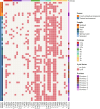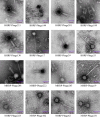Isolation and relationship analysis of Listeria phages with various serotype hosts and morphological characterization
- PMID: 40251606
- PMCID: PMC12007378
- DOI: 10.1186/s12985-025-02706-w
Isolation and relationship analysis of Listeria phages with various serotype hosts and morphological characterization
Abstract
Listeriosis, caused by Listeria monocytogenes (Lm), is a severe foodborne illness with a high fatality rate. Listeria phages specifically target and lyse Lm, offer a promising alternative for biocontrol and phage therapy. However, most existing studies focus on the lytic characteristics of Listeria phages using limited sample sizes. In this study, a large number of Listeria phages were isolated from diverse sources, and their lytic profiles and morphology were characterized. A total of 317 Listeria phages were isolated from 90 food-related environmental samples and 196 natural environmental samples collected across seven provinces. The phages were tested for lytic activity against 35 Lm strains representing nine serotypes, and their morphology was characterized using transmission electron microscopy (TEM). Statistical analysis was conducted to evaluate the lytic patterns of phages. The phages were classified into three groups based on their total lysis ratios. Broad Host Range Phages (BHRP) were primarily members of the Myoviridae-like phages and demonstrated the ability to lyse a vast majority of nine serotype host strains. Medium Host Range Phages (MHRP) comprised both Siphoviridae-like and Myoviridae-like phages, and demonstrated lysis of 6-9 serotype strains. Narrow Host Range Phages (NHRP) belonged to the Siphoviridae-like phages and exhibited effective lysis of serotype 4 strains. Furthermore, phages isolated from food-related environmental sources demonstrated greater lytic activity against Listeria serotypes 1/2b, 4a, and 4c compared to those derived from natural environmental sources. The study first isolated a multitude of Listeria phages, elucidated their lytic patterns and ecological distribution, and provided a valuable resource for future research.
Keywords: Listeria monocytogenes; Listeria phage; Ecological distribution; Lytic profiles; Morphology.
© 2025. The Author(s).
Conflict of interest statement
Declarations. Ethics approval and consent to participate: Not applicable. Consent for publication: Not applicable Conflict of interest: The authors declare that they have no Conflict of interest.
Figures






Similar articles
-
Characterization of a Novel Group of Listeria Phages That Target Serotype 4b Listeria monocytogenes.Viruses. 2021 Apr 14;13(4):671. doi: 10.3390/v13040671. Viruses. 2021. PMID: 33919793 Free PMC article.
-
Characterization of Listeria prophages in lysogenic isolates from foods and food processing environments.PLoS One. 2019 Apr 1;14(4):e0214641. doi: 10.1371/journal.pone.0214641. eCollection 2019. PLoS One. 2019. PMID: 30934000 Free PMC article.
-
Characterising the biology of novel lytic bacteriophages infecting multidrug resistant Klebsiella pneumoniae.Virol J. 2013 Mar 28;10:100. doi: 10.1186/1743-422X-10-100. Virol J. 2013. PMID: 23537199 Free PMC article.
-
[Bacteriophages and bacteriocins of the genus Listeria].Zentralbl Bakteriol Mikrobiol Hyg A. 1986 Feb;261(1):12-28. Zentralbl Bakteriol Mikrobiol Hyg A. 1986. PMID: 3085381 Review. French.
-
Renewed insights into Ackermannviridae phage biology and applications.Npj Viruses. 2024 Aug 21;2(1):37. doi: 10.1038/s44298-024-00046-0. Npj Viruses. 2024. PMID: 40295767 Free PMC article. Review.
References
-
- Disson O, Moura A, Lecuit M. Making sense of the biodiversity and virulence of Listeriamonocytogenes. Trends Microbiol. 2021;29(9):811–22. 10.1016/j.tim.2021.01.008. - PubMed
-
- Hurley D, Luque-Sastre L, Parker CT, Huynh S, Eshwar AK, Nguyen SV, Andrews N, Moura A, Fox EM, Jordan K, Lehner A, Stephan R, Fanning S. Whole-genome sequencing-based characterization of 100 Listeriamonocytogenes isolates collected from food processing environments over a four-year period. mSphere. 2019;4(4):10–1128. 10.1128/msphere.00252-19. - PMC - PubMed
-
- Leclercq A, Chenal-Francisque V, Dieye H, Cantinelli T, Drali R, Brisse S, Lecuit M. Characterization of the novel Listeriamonocytogenes PCR serogrouping profile IVb-v1. Int J Food Microbiol. 2011;147(1):74–7. 10.1016/j.ijfoodmicro.2011.03.010. - PubMed
Publication types
MeSH terms
LinkOut - more resources
Full Text Sources

